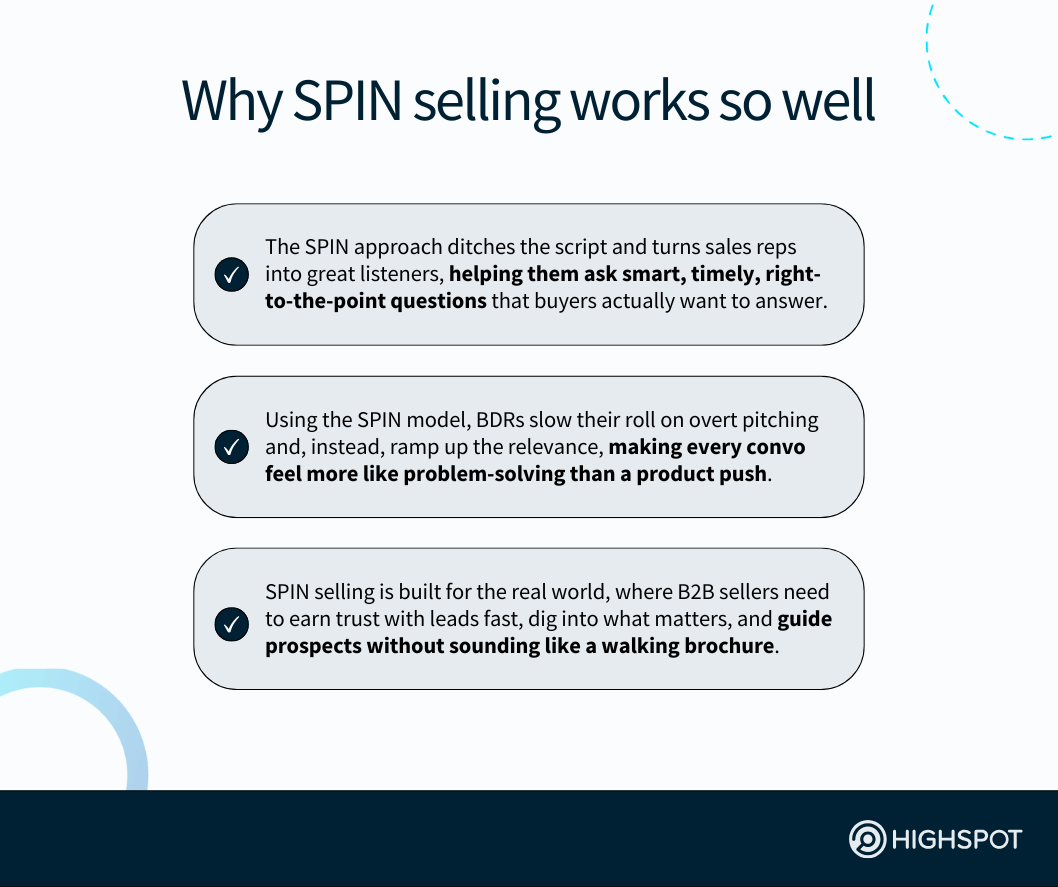Key Takeaways
- Using the SPIN selling method gives sales reps a proven way to uncover buyer needs, build trust, and drive better outcomes through structured, consultative conversations that lead to stronger engagement.
- The SPIN sales approach equips sellers to ask smarter questions, handle objections with confidence, and guide prospects toward value, making it especially effective in complex B2B sales cycles.
- High-performing teams use SPIN questions that surface urgency, clarify impact, and connect solutions to buyer goals, turning everyday sales conversations into moments that consistently move deals forward.
Most B2B buyers don’t follow a linear sales funnel anymore. They conduct extensive research into vendor options and look into leading companies on their own.
With many stakeholders involved and multiple communication channel preferences, it’s more important than ever to have a deeper understanding of leads.
That means ditching dated, more traditional sales tactics and techniques that emphasize product-driven solutions, as those no longer work in today’s demands.
To meet the needs of potential customers, sales teams like yours must shift to a customer-centric and value-driven approach. That’s where SPIN selling comes in.

What is SPIN selling?
SPIN selling is an effective consultative selling technique that helps B2B sales reps better engage buyers through thoughtful questions that uncover real business needs.
SPIN stands for situation, problem, implication and need-payoff, a framework that guides reps to ask the right questions in the right order in deal discussions.
This method was first introduced by business consultant and sales expert Neil Rackham in the late 1980s. Since its creation, it has become a proven approach for leading more impactful discovery and building trust with prospects on sales calls.
- Rather than pushing a product, SPIN selling encourages sales force members to explore pain points and connect solutions to what buyers truly care about.
- The SPIN sales method equips teams to develop stronger customer relationships, drive value-based conversations, and differentiate in a crowded market.
- SPIN also helps sales reps move beyond surface-level questions to uncover the root of a lead’s challenges, leading to better outcomes and more strategic deals.
When executed well, SPIN selling enables teams to realize sustainable and scalable sales success by aligning to buyer needs and making every sales call count.
Why SPIN selling is so popular today
“Smart leaders know that a comprehensive, thoughtful GTM strategy and its following initiatives can turbo-charge their business and provide a wealth of opportunities for revenue growth and business transformation,” according to Highspot’s GTM 101 Guide.
“By defining each component of that GTM strategy, enabling sellers to execute with confidence, and continually measuring and optimizing your approach, your business has the incredible opportunity to not only beat its competitors but also reach new revenue heights,” our go-to-market guide continued.
Realizing this level of go-to-market and revenue success, though, is dependent on not just implementing the right sales methodology but also fine-tuning the small details in your sales process—including reps’ buyer engagement approach.
That’s what leading GTM understand, and why they have their sales organizations employ SPIN selling. Some of the notably benefits is that the approach:
Aids B2B sellers with objection-handling
Using the SPIN selling method, BDRs can redirect leads’ resistance into opportunity, when a would-be-customer raises concerns on a sales call. The framework gives sellers a structure for handling pushback with poise instead of panic.
Asking SPIN questions (more on those shortly) helps sales reps uncover the real reason a prospect might be hesitating. Leading with empathy, not explanations, is more powerful than traditional sales techniques in these moments.
The top sales forces today use the SPIN method to reframe challenges presented as shared hurdles, not deal-killers, and work fast to provide clear answers.
Helps reps enhance their closing techniques
What makes SPIN selling one of the best validated sales methods is that it doesn’t make closing feel like a sprint to the finish line. Rather, it makes it feel like a natural next step—the logical progression for a potential customer’s buying journey.
More to the point, it helps sales reps shift from pressure to clarity by summarizing key points and inviting the buyer to take action. Using the SPIN model, sellers get aligned with the lead’s reality so the close lands softly and sticks.
The most successful sellers today use SPIN to earn a “Yes” that doesn’t come from persuasion but from precision. It’s like guiding the prospect down a path they helped pave, making close deals feel like mutual wins instead of last-minute plays.
Sharing real-world examples of customers thriving with your company and seeing substantial business growth using your offerings is what ultimately leads to sales effectiveness using the SPIN method versus conventional selling methods.
Our GTM Performance Gap Report breaks down how—regardless of your distinct sales approach or methodology today—AI can empower your reps to sell smarter.
Keeps BDRs focused on key points on calls
SPIN selling is a cheat code for BDRs trying to stay on track during high-pressure discovery calls. It anchors chats in active listening instead of jumping into pitch mode too soon.
All sales conversations with ‘warm’ prospects who fit your ideal customer profile benefit when reps stop guessing and start guiding with data-informed insights.
Because when calls flows around what matters most to a given decision-maker at a target account, even a cold call can warm up quickly. And, suddenly, qualifying feels less like a task and more like the start of something meaningful.
Many sales leaders are investing in leading GTM tools with native conversation intelligence solutions, like Highspot, to empower their reps’ SPIN selling.
Highspot, specifically, makes it easy for sellers and managers alike to surface AI-powered insights during and after sales calls to inform adjustments to future calls.
Leads to consistently higher sales conversions
When reps apply the SPIN model with consistency, deal discussions shift from shallow to strategic, and reps execute more successful sales calls, as they can more easily spot where real value lives and tailor a sales pitch to land with precision.
By embedding winning behaviors into every rep’s rhythm, conversion rates climb without artificial lifts. And, unlike silver bullets or shortcuts, SPIN selling keeps working, deal after deal—regardless of a lead’s industry, vertical, or business model—because it’s grounded in how people actually make decisions.
It also leads to a greater likelihood of closing larger sales with high-value accounts, since account executives can hop in the sale cycle and apply the same question-oriented approach to all key executive stakeholders.
4 stages of the SPIN selling method
The SPIN selling methodology follows a structured approach through four buying stages.
Each stage is designed to guide sales reps in managing conversations as the buyer’s journey progresses and integrates the four types of questions to facilitate targeted discussions.
For instance, a discovery call might begin with SPIN situation questions to establish context. On the other hand, follow-up discussions might dig into problem questions to identify issues.
Rackham reported having a solid questioning strategy can increase your close rate by 20%.
Simply put, successful salespeople ‘pull’ their specific solutions later on in the sales cycle, focusing first on the customer’s situation and the impact of their problems.
This strategy encourages prospective customers to recognize their own need for a solution and often leads them to conclude that your offering is the best fit.
Here is how the four stages work:
1. Opening or preliminary stage
Begin with light, open-ended situation questions to gauge professional needs and personal interests of prospects. Build rapport with potential clients.
Focus on understanding their situation and expressing genuine interest in their experiences and issues. Try not to push features or functionality early in the conversation.
2. Investigating stage
Focus on uncovering the lead’s specific pain points with problem questions.
This investigative phase is crucial for identifying underlying issues that your company’s solutions can address. Balance the need to prompt and guide the sales conversation without overwhelming the prospect with interrogative questions.
3. Demonstrating capability effectively stage
Transition into business implication questions to explore the consequences of not investing in an offering like yours and highlight the need for your solution, specifically.
Talk about the value of solving the problem in question. Once you’ve connected well with your prospect, they’re now open to hearing how your product or service can help them.
4. Obtaining commitment stage
Encourage a small step forward with need-payoff questions. This could be a trial, follow-up meeting, or a final deal. This step guides the client to move forward to the next steps.
At this point of the deal cycle, it’s important for your sales team to reflect on what worked and what didn’t in each customer interaction to make future deals even better.
SPIN selling questions for sales calls
Today’s B2B buyers are more complex (and difficult to reach) than ever before.
To build the necessary relationships that further the sales process, sales reps must ask the right questions at the right time. The SPIN model provides structure to address buyer objections while avoiding an overwhelming interrogation.
Being prepared with purposeful questions facilitates a far smoother sales process and improves business and revenue outcomes. So, let’s turn theory into practice and examine questions that fit the SPIN selling method category and stage.
Situation questions
It’s common for sales professionals to prematurely focus on their product without understanding the prospect’s situation, often leading to a sales pitch that falls flat.
Instead, sales reps should open with situation questions to gauge the customer’s current context, challenges, and how they think they compare to others. This helps you tailor follow-up questions and align your product or service with the prospect’s perceived or actual needs.
| Situation questions to ask buyers |
| Can you tell me about your particular role and duties at your company? |
| Walk me through an average day at your job? What do you focus on? |
| What is your organization’s distinct approach to [specific use case]? |
| Can you tell me about your current processes tied to [specific use case]? |
| Why did you invest in these tools? Why did you invest in those solutions? |
| How effective do you find these resource? How often do you use them? |
| Who is responsible for ensuring success/ROI with [specific use case]? |
| How much of your company’s budget is assigned to solving [problem]? |
| What is your top priority for the year? Why is this priority so important? |
Benefit of asking these questions: These help your reps uncover the core challenges a buyer faces so they can tailor the conversation around real business needs.
Problem questions
Instead of pitching your product immediately, focus on understanding the prospect’s goals and the hurdles they face. Use this opportunity to help them recognize their own issues. Ask questions that explore what’s holding them back and what they aim to achieve.
| Problem questions to ask buyers |
| What types of business challenges do you anticipate in the coming year? |
| What is your biggest day-to-day challenge you’d love to address soon? |
| How easy or hard is it to make progress against [business priority/goal]? |
| Why does your current approach work or not work? Does it ever fail? |
| What happens if you’re not successful with achieving [business objective]? |
| In a perfect world, what would your approach look like to solve [problem]? |
| Do you think [problem] can be solved? What’s stopping you from solving it? |
Benefit of asking these questions: Sellers get a baseline understanding of the buyer’s current state so they can ask more focused and relevant follow-ups.
Implication questions
Initially, the problems may seem like minor inconveniences. Encourage the prospect to explore the consequences if the issues are not addressed.
Actively listen and discuss the broader outcomes, emphasizing the urgency of finding a solution. This part of the conversation is where you truly understand their needs while indirectly pitching your product’s features and benefits.
| Implication questions to ask buyers |
| Has the business ever missed a KPI due to your current approach? Why? |
| What is the cost of your current approach to trying to solve [problem]? |
| How much time, resources, and energy does your current approach require? |
| What goal do you want to achieve but currently can’t because of [problem]? |
| How is [problem] negatively impacting your personal work/your team’s work? |
| Is [problem] negatively impacting your customers’ experience as well? |
| Would resolving [problem] better enable you to advance your career? |
Benefit of asking these questions: Your BDRs are able to encourage buyers to connect their problems to broader ripple effects, helping build urgency and business-level impact.
Need-payoff questions
It’s time to gauge the problem’s urgency and set the stage for closing. Encourage the prospect to articulate the value and benefits of a solution in their own words.
As they do this, they’ll start to see the real value themselves, which can naturally lead to a decision. So, ask questions that help them think through what changes once the problem is solved—this can be a real eye-opener and a pivotal moment in the conversation.
| Need-payoff questions to ask buyers |
| What would change at your organization if you did [approach] differently? |
| How much easier would it be to achieve [business priority] with [solution]? |
| Would your business unit get substantial, long-term value from [solution]? |
| Big picture, how will solving the [problem] ultimately help your company? |
Benefit of asking these questions: Buyers are prompted to articulate the tangible value of solving a problem, making the benefits feel personal and clearly worthwhile.
How SPIN selling training can teach your reps how to close major sales
Specialized SPIN sales training program, offered by organizations like Huthwaite International, sharpens the unique skills needed to ensure successful sales.
- The hands-on training uses interactive activities that mirror real-world sales situations, helping sales reps build confidence and make quick, impactful decisions.
- It covers skills such as knowing when to shift tactics, analyzing why sales fail, and incorporating SPIN sales techniques across different sales channels.
- This training also emphasizes the importance of adapting to current market trends, spotting new sales opportunities, and maintaining a solid strategy even when sales must be conducted virtually.
Integrating this program (or another sales training program that specializes in the SPIN selling methodology) into your sales training software further enhances its effectiveness by providing a scalable and flexible platform for continuous learning and practice.
Sales teams can track their progress, receive personalized feedback, and engage in realistic simulations that reinforce key SPIN selling principles.
Realizing a more successful B2B sales process with the SPIN strategy
By honing the SPIN methodology, your team can establish routine and rigor in your sales strategy, ultimately boosting rep confidence and sales performance.
While there’s no one-size-fits-all methodology, SPIN selling is a great example of how a targeted, cohesive, buyer-first approach can work wonders for your sellers and—bigger-picture—drive stronger overall go-to-market performance.
That said, we know you likely have some questions about SPIN selling, including how to best implement the method to drive scalable, repeatable sales success. Some common Qs we hear from GTM leaders regarding the approach include:
Is SPIN selling still relevant for B2B sales?
The SPIN sales methodology remains pertinent because it focuses on real buyer needs instead of scripted pitch tracks. It leads to more effective sales performance for sellers by helping them ask better questions and build stronger trust across the sales cycle, especially in complex B2B environments.
How can I best implement SPIN selling today?
Start by mapping SPIN selling questions to each stage of your current sales motion and coaching reps to ask them at the right times and with intent. You can modify current processes without overhauling your playbook, especially if you embed SPIN into discovery, qualification, and content personalization moments.
What are the best sales tools for SPIN selling?
Sales enablement platforms like Highspot that support rep training and development, lead engagement, and real-time coaching are essential for SPIN success. Choose tools that help surface pain points and guide sellers on sales calls with content, plays, messaging, and insights tailored to buyer needs and business context.
Can I blend SPIN selling with other techniques?
Yes, SPIN complements other frameworks like Challenger Sales or MEDDPICC, as long as discovery questions remain focused on the buyer’s distinct needs. It strengthens any methodology by prioritizing insight-led questions over traditional sales methods and driving consistent value in every conversation with buyers.
Which SPIN selling mistakes must we avoid?
Avoid rushing to pitch or skipping implication questions. Both errors weaken your value story and stall deal progress. If your reps don’t understand leads’ problems before proposing your products or services, they’ll lose credibility and likely struggle with obtaining commitment from key decision-makers on sales calls.
Should we refine our SPIN selling questions?
Yes, continuously adjust your SPIN questions based on prospect feedback, deal outcomes, and customer trends to make every call count. Great SPIN conversations are structured but never scripted, and the most successful sellers today alter their approach to match buyer context, industry nuance, and purchase intent.
Does SPIN selling help increase sales volume?
SPIN selling improves conversion rates by turning what could be generic sales conversations into tailored value discussions that build urgency. When executed consistently, it helps reps become more successful salespeople and drives meaningful revenue growth across segments, regions, and product lines.
How can I teach my reps SPIN sales behaviors?
Use real buyer scenarios via sales role play to coach your BDRs on how to ask and sequence SPIN questions effectively. Reinforce the behaviors that work with consistent practice, feedback, and examples of how those tactics accelerate pipeline and shorten the sales cycle in different selling motions.
What’s the ROI of SPIN selling for B2B sales?
When SPIN selling is executed effectively, it helps sales representatives qualify better, close faster, and waste less time on bad-fit prospects. It also aligns discovery to decision-making and ensures reps are always driving toward the next logical step, especially when closing or dealing with pushback from hesitant buyers.




